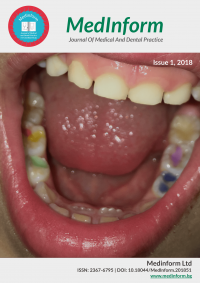Issue One 2018
2018, Vol. 5 issue 1, (January)
Original Article
Corrosion potential in oral cavity
Abstract:
Different metal alloys are used for restoration in dental practice. As a result of electrochemical processes, metal objects in the oral cavity become electrically charged and can lead to generation of corrosion potential. This phenomenon can be manifested as pathogalvanism and is characterised by complaints of metallic taste, paraesthesia, tingling, burning, various inflammatory processes, etc. Its clinical manifestations are diverse and quite common. The corrosion potential of dental alloys in the oral cavity depends on their composition, the degree of polishing, the structural changes occurring during their placement and the time elapsed since their placement.
In 42 patients with metal restorations, we found that dental amalgam predominates amongst the metals used to repair lost hard dental tissue, mainly in molars. 78.4% of the metal objects in the oral cavity are amalgam, as 78% of restorations are on molars, and 19% on premolars. The majority of metal restorations are in the upper jaw (57%), 41% of patients have only one metallic restoration, 14% have over three metal objects. Very few of the corrosion potential values exceed the norm – only 4% of the samples tested, despite the presence of more than one metal in the same oral cavity – 17% of the subjects. We found no patient with increased total corrosion potential. The presence of pathogalvanism with elevated values are seldom.
Authors:
Vladimir Panov; Department of Conservative Dentistry and Oral pathology, Faculty of Dental Medicine, Medical University of Varna;Martina Markova; Department of Conservative Dentistry and Oral pathology, Faculty of Dental Medicine, Medical University of Varna;

